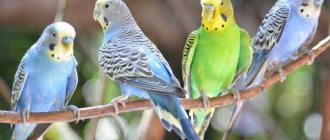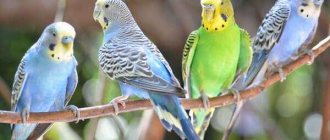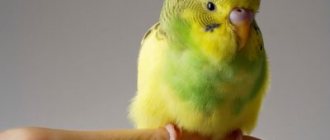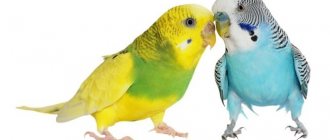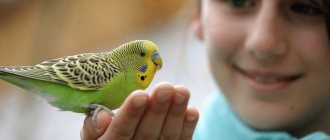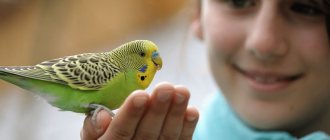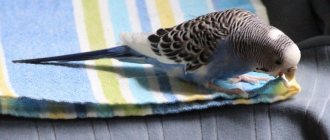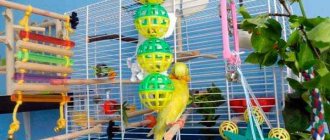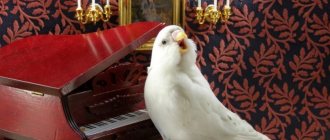To uninitiated people, the singing of budgies may seem like meaningless bird chatter. After all, parrots are not the usual dogs or cats, whose habits have long been studied and understood. However, they are the same living beings, having their own preferences, individual character and even personal opinion. With the help of bird trills and a special behavior characteristic of a particular case, a parrot can tell its owner about its needs, the joy of meeting a person, or, conversely, express dissatisfaction.
After reading the article, you will learn how to decipher bird language and learn to better understand your pet. You will also be able to see with your own eyes all the variety of dances and hear what sounds parrots are capable of making while living side by side with humans.
Rosella parrots and their description
Rosella is a bird of the parrot family. This species includes 4 subspecies (7 depending on plumage), differing in color and habitat.
By nature, the rosella parrot is a free parrot, loving wild areas, living on the island of Tasmania, and their most popular subspecies is the variegated rosella parrot (the belly of such parrots is green, and the color is in the form of scales), in the southeast of Australia. For many years, these parrots kept their distance from people, afraid to fly even to the nearest settlements. But over time, circumstances forced them to move closer to people, because due to the growth of the bird population, there was less and less food in the fields.
When parrots lived in open areas (fields, savannas and steppes), they mainly fed on larvae and plant seeds, and after moving to human gardens and orchards they switched to vegetables and fruits. Over time, when rosellas began to become parasitic, people began to look for ways to combat them, gradually catching the birds and selling them as pets. As it turned out, they very quickly get used to human society and are able to serve him faithfully.
Life in natural conditions
Rosellas are representatives of the Australian continent and the island of Tasmania. In nature, they lead a gregarious lifestyle. They live in deciduous forests and prefer to stay close to water. When rivers dry up, birds have to roam within their range. Rosella is considered a forest health worker and benefits agricultural lands as it eats slugs, harmful insects and caterpillars. However, while destroying pests, the parrot feasts on fruits and destroys crops.
A beautiful parrot with a scaly color feels free next to a person, so flocks of colored birds can be seen in parks and gardens.
Reproduction
The parrot is ready to breed starting from the age of one and a half years. Males court females very actively: they dance, coo, and show themselves in all their glory. Trying to please the bird he likes, the male offers her something edible. The female favorably accepts the treat, and after this mating occurs.
Birds look for suitable shelter to lay eggs. Rosellas do not build nests, but use hollows and abandoned nesting sites of other birds to hatch chicks. Some individuals climb into rabbit holes or holes in rocky river banks. There are similar nests on fences, poles, and also under the roofs of houses.
Having settled comfortably, the female begins to lay eggs - one egg per day. Gradually the clutch increases, soon there are from 3 to 7 eggs. While the female is sitting on the nest, her partner brings her food. Over the course of 22-24 days, the expectant mother warms the clutch, and then the chicks appear - blind, covered with white down. After about a week, their eyes open, and by the thirtieth day, real feathers grow. The chicks try to fly, then learn to look for food, gain independence and leave the nest. The young remain in their native flock, the number of which is regulated according to the principle of natural selection.
Lifespan
How long a Rosella parrot can live depends on its environment. In the wild, parrots are constantly in danger:
- predator birds;
- drought, crop failure;
- Forest fires;
- mass shooting or capture by poachers.
Under natural conditions, the lifespan of rosellas is on average 7 years. Parrots living in captivity may die at an early age from illness or injury, or may reach a very old age. The normal lifespan for this bird is 25 years. For a parrot to live this long, a combination of many aspects is necessary: proper diet and care, housing, and the attention of the owner. We'll talk about this further.
Varieties of Rosella parrots
At the moment, in nature there are 7 species of rosella parrot, which got their name solely because of the color and type of plumage, these are:
- red rosella parrot;
- pale-headed rosella;
- variegated rosella;
- green rosella;
- black-headed rosella;
- yellow-cheeked rosella;
- collared rosella.
The most popular among parrot breeders remains the mottled rosella species, but there are often some difficulties in finding chicks of this species without any admixture. Purebred is highly valued among experienced breeders, because crossed birds can be susceptible to many diseases that are very difficult to cure.
Appearance of Rosella parrots
The average body length of a rosella is about 30 cm, while the length of the wings is slightly more than 10 cm. It is worth knowing that all sizes are individual and can fluctuate by a couple of centimeters. Depending on the birds’ diet, their weight ranges from 52 to 60 kg.
The main feature of rosellas is their plumage, which resembles fish scales. Each feather has a black “edge” that contrasts greatly with the belly feathers of the birds. To distinguish a female from a male, you need to pay attention to the color intensity of the birds. If the color of the plumage is dull, then it is a female, and if the plumage is bright, then it is a male. Such a bright color is necessary for males to attract females during the mating season. It is also necessary to pay attention to the shape of the beak and head. If the beak and head resemble a circle in shape, then it is a female, otherwise it is a male.
Characteristics and features of Rosella parrots
Among other parrots, Rosella is distinguished by its diligent character and high level of intelligence. With proper upbringing, birds can be trained in every possible way, giving various rewards, for the sake of which the birds will intuitively do what they were rewarded for and develop a habit out of it. Very often there are cases when birds try to repeat the sounds that they hear most often (a dog barking, a bell, an alarm clock, and the like).
By nature, rosellas are musical birds. Possessing a very pleasant voice and a good sense of rhythm, you can hear the Rosella parrot singing around the clock. In order for the bird not to interrupt the night's rest, you should show it that the owner does not like it, and over time they will know at what time they should not sing.
When getting a rosella, you should take into account the fact that they do not like to be in the company of other birds. And if the birds are smaller than the parrot itself, then they will show power in front of them in every possible way. It is better to have a couple (male and female) of birds of the same species and age.
Why do budgies like to sing and dance?
Watching budgies sing or dance is very funny. Moreover, such dances delight not only people, but also the most birds.
- Innate data. It has been proven that birds have an innate sense of rhythm. Therefore, upon hearing a piece of music, parrots often break into a dance or begin to loudly sing along to the beat of the melody. Such activities make the bird very happy, and also lift the spirits of the people watching this spectacle. But it happens that by nature, a bird is not a music lover, and you should not be surprised when it does not respond to the melodic sounds of a song.
- Imitation. Ornithologists say that in addition to their innate love of music, parrots also have good imitative abilities. After all, dancing skills usually manifest themselves in those birds that have lived in captivity for a long time and observed the behavior of people. Birds see how people behave to the music (singing along, dancing along), and then they themselves try to copy the behavior.
When training dogs, a reward method is used - for every trick they perform, they receive a treat. But budgerigars sing and dance just like that, according to their mood, and do not ask for additional payment for demonstration performances.
Video Parrot dancing
What kind of music do budgies like to listen to?
Budgerigars have no special musical preferences. The main thing for them is the feeling of rhythm in music. It is true that there are individuals who prefer classics, and some even rock, but this is more related to the preferences of their owners. What the bird hears more often, what it gets used to more, it likes more.
Budgerigars perceive dance tunes with words better. And compositions without lyrics make them depressed, indignant, and they respond loudly with disapproval.
Melodies for developing speech skills
Experts advise playing music for budgies all the time. After all, in addition to developing gaming abilities, this stimulates conversation. It has been proven that regular listening to music tracks speeds up the process of learning human speech. To benefit from music listening and teach your pet to speak, you need to follow these recommendations:
- Set a regular time for listening to music (ideally in the morning before feeding).
- Play the same excerpt of a song every day.
- Be sure to take into account the choice of the parrot (if the chick does not like the composition, he will ignore it and will not teach it).
- Create a calm atmosphere in the house, eliminate all irritants.
- Do not shout, do not get angry, do not raise your voice at the bird.
- Hold the chick in your hand.
- Praise the parrot even with small successes (give a treat if desired).
Budgerigars are very smart pets. By following the above recommendations, you can very quickly make progress in your studies from birds and hear the first phrases.
Video Parrot Richie. He speaks and sings.
Rosella parrot nutrition
When thinking about the diet of birds, you should think about what they eat in their homeland. The standard diet of rosella is various grains and cereal mixtures, which from time to time should be supplemented with products of both animal and natural origin.
Products of animal origin include:
- Dairy products (if the bird does not refuse to eat them);
- Boiled eggs (especially if the bird is feeding chicks or has survived an illness);
- Larvae, worms, ants, bugs;
- Bloodworm.
In addition, food for rosella should be enriched with calcium. In addition to food, there should be chalk in the parrot’s cage (it can be either special store-bought or regular chalk). To maintain the health of the beak (especially if it begins to peel off), and simply for general immunity, crushed and washed egg shells should be kept in the cage.
Maintenance and care of Rosella parrots
When placing a cage for a parrot, you should take into account the temperature, humidity and direct exposure to sunlight. Under no circumstances should you place a bird cage in a stuffy room (such as a bathroom, kitchen, boiler room, etc.). It is also desirable that the cage is away from direct sunlight, but not deprived of light. The best option in order to ensure decent maintenance of the rosella is to place a cage at the table in the bedroom or living room so that the bird can constantly be the center of attention and monitor all events.
Choosing the right words
Unlike some other breeds of parrots, Rosella can remember no more than 10 simple words or phrases, so there is no need to set more serious tasks for the bird during training. The first words that your pet can learn should consist of one or two simple syllables and contain vowel sounds, hissing and [p], [t], [p]. Often the first word that Rosella remembers is the name of the parrot itself or its owner. These birds are good at learning words of greeting and farewell (“hello”, “bye”), and question phrases like “how are you?” or “how are you?”
Also, these parrots can miraculously reproduce the sounds that other birds make and whistle the melodies they hear. Moreover, they remember them much faster than words and phrases. But you should not start training by memorizing melodies, as in this case the bird may not speak at all.
Rosella parrot: care
Caring for birds is not difficult - you regularly need to change the filling of the bottom of the cage and wash it once a week. If a bird lives in a new cage for the first time and very quickly makes a mess there, then you need to accustom it to cleanliness: if the cage gets very dirty every day, then you still need to clean it once a week. The bird will understand that it has to live in this mess, and will become more careful. Due to the fact that she loves to swim, you need to run her under the tap or fill containers filled with warm water so that the bird can fit in completely.
Since Rosella leads an active lifestyle, you should not keep it in a cage around the clock. If the bird is not yet accustomed to its new home, then you should let it out for a walk for half an hour every day. Over time, you can add more time, and soon you can even keep the cage open regularly.
Rosella health and diseases
A healthy parrot can live up to 15 years, and even reliably produce offspring if it feels safe and finds a good partner. By purchasing a parrot from trusted dealers, you can be sure that they will be healthy (at least at the time of purchase). You should not take birds that look weak or their parents were of different species. Such chicks are very susceptible to many diseases due to their unstable immunity.
To prevent diseases, you need to monitor the food and the vitamins it contains. You can also take vitamin complexes for prevention. If the bird behaves strangely (refuses to eat, does not want to bathe), then it should be shown to a doctor).
Taking on a rosella is a big responsibility and therefore their well-being depends entirely on the owner. By properly caring for your bird, you can get a faithful friend for many years.
Summarizing
A budgie, like any other pet, requires sufficient time and attention from its owner. If the owner is patient and regularly works with his pupil, then soon the training will bear fruit - the bird will speak, repeating not only individual words, but also entire sentences. He will copy intonation, surrounding sounds, and delight family members with dancing and cheerful singing.
An attentive owner who has studied the habits of a feathered pet will be able to find a common language with it. This will make it comfortable for both the bird, whose needs will be understood and satisfied, and the owner, who can quickly determine by the behavior and singing of the budgerigar his emotional state, the cause of anxiety or joy.
